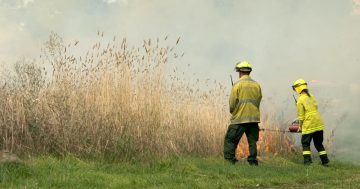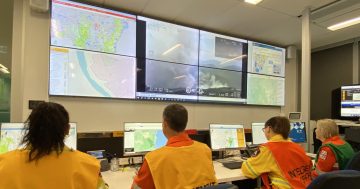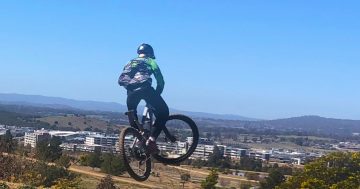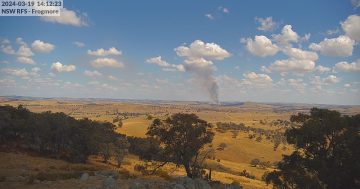
The charred ruins of Binnaburra Mountain Lodge from the air. Photo: Facebook.
Only a few weeks from now we were booked in to the Binna Burra Mountain Lodge on the Gold Coast hinterland but now our holiday dreams are like the historic rainforest resort – in ashes.
For 90 years local, interstate, and overseas visitors – no doubt many from Canberra – enjoyed the resort’s old-world charm and the surrounding Lamington National Park, including a stand of ancient Antarctic beech.
I grew up in south-east Queensland where exploring the scenic rim rainforest was a rite of passage. We took our children to Binna Burra, both camping and eventually staying at the Lodge, with its magnificent views, mountain air and amazing forest treks.
It was a respite from the summer heat, with the hills and mountains clad in moist, dark green and refreshed by regular afternoon thunderstorms.
Now the rain has disappeared, the forests are desiccated and they are burning – in September, what used to be the gentlest of months.
Last year, the northern parts of Queensland went up in flames. This year it is the south’s turn, with the Granite Belt and over the border to Tenterfield also a tinder box.
Here in the ACT the official bushfire season starts on 1 October, but Bega Valley and Eurobodalla launched theirs two months earlier than usual, with a blaze in Cobargo late last week putting the wind up residents.
The drought, the wind and loads of fuel is an explosive combination that has firefighters fretting about what’s to come when summer comes.
An ‘omen’, ‘unprecedented’, the ‘new normal’ – that’s how they are describing the spring conflagration. But this isn’t happening out of the blue; climatologists from the Bureau of Meteorology, without referring to the elephant in the room, talk about the warming drying trend being apparent for many years now over winter.
It’s a pattern happening on a global scale, with fires increasing in frequency and ferocity.
We know what the science says – the world is warming, the burning of fossil fuels is to blame and the climate emergency is here.
Yet we have a political leaders who dither and obfuscate, who pay lip service to international accords on cutting greenhouse gas emissions and seem all too willing to let the deniers and doubters erode policy decisions so the very industries that we need to move away from if disaster is to be averted remain protected and allowed to expand.
I can see the response of some of them and their mates in the Murdoch press response now to anyone drawing attention to the obvious, labelling them despicable for politicising tragedy and hysterical for sounding the alarm.
Or telling us nothing would have stopped what has happened, and asking why should Australia stick its neck out and risk its economy when the rest of the world keeps building coal-fired power stations, and anyway the science isn’t settled, and we’ve always had droughts and bushfires.

Binna Burra Mountain Lodge shrouded in mist. The owner will rebuild but for a changed climate. Photo: Binna Burra Mountain Lodge.
This week as Parliament resumes, we have a Government whose priorities are beyond twisted. As the forests burn, our farms turn to dust and the rivers run dry or give up its gasping fish, it wants to punish our most vulnerable and bash unions.
It talks big on national security, eating away at our basic freedoms, while not moving to secure the most precious asset that we have – the environment.
It boasts that we punch above our weight in international affairs, which usually means yet another military venture in the Middle East, but believes it has no leverage to show leadership when it comes to action on climate change.
And its Labor opponents take pot shots from the barbed wire fence they sit on, while drawing the wrong lessons from its electoral humiliation.
It may be already too late to avert a disastrous rise in temperatures and their consequences but our leaders need to get real and start tackling the issue like a military operation to not only contribute fully to the transition to a low-emission world, but also to abate the damage and fallout happening now and to come in the years ahead.
It’s about our health, food, water, where and how we can live.
It isn’t enough anymore to offer, as the Prime Minister did, all the support the affected areas need without realising the ongoing gravity of the new order. They need to cut loose the deniers in their own parties, think long-term and be frank with the people. They need to take the lead and accept what their beloved markets have already factored in – that the move to renewable energy is well and truly on. It may even need a Government of national unity.
It is beyond ideology because what is at stake is the very inheritance we bequeath to our children and grandchildren.
The loss of Binna Burra and the burning rainforest is yet another shocking wake-up call. How many more do we need?


















